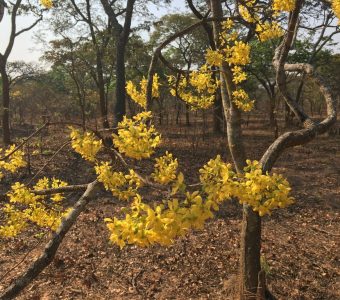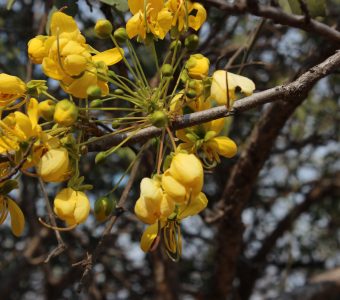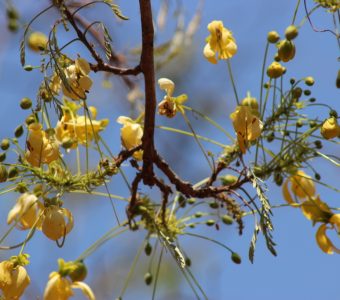


Botanical Name: Cassia abbreviata
Common Name: Long-pod Cassia, Munsokansoko, Mululu, Kapatati, Mululwe, Mkoswe
Plant Family: Fabaceae (Legume Family) Caesalpinoideae
Growth Form, Habitat and Distribution: A deciduous shrub or small tree, often crooked, multi-stemmed with an open rounded crown. Occurs widely across Zambia often on termite mounds, and in most woodland types, except parts of Western Province. Cassia is best known for its abundant fragrant yellow flowers in Sept – November and its amazing long pods which are Cylindrical, brown, velvety pod (up to 90cm) at ends of branchlets, ripening December to April, containing numerous flat brown seeds in a sticky pulp separated by septa. Pods often remain on the tree for several months. Grows fairly well and makes a good garden plant but a bit slow. A food plant for several inspect species.
Size: Height up to 14m, spread 4 to 8m.
Uses: An extract of the roots has sometimes been used by traditional medicine to treat blackwater fever but is otherwise regarded as poisonous. The leaves are smoked as a treatment for haematuria, whereas the smoke of smouldering twigs is inhaled to cure headache. A root infusion is kept in the mouth, or roots are chewed and swallowed to relieve toothache. A root decoction or the dried powdered roots in water are drunk to treat gastrointestinal disorders, stomach-ache, bilharzia, venereal diseases, pneumonia, uterus complaints, heavy menstruation, snakebites, and as a purgative, stomachic, aphrodisiac, abortifacient and vermifuge. Malaria (including blackwater fever) is also treated with extracts from the roots. A water extract of the roots is used as an eyewash to cure ophthalmia. The powdered stem bark is applied to abscesses and added to food to cure diarrhoea. A decoction of the stem bark is used as a purgative and to cure malaria and diarrhoea. The seed is used as a tonic.
The wood is used to make furniture, pestles and joinery. It is termite resistant and therefore the poles are preferred for house construction. The wood is also a useful source of charcoal and firewood Cassia abbreviata is important in soil conservation and as a shade tree. The flowers are highly appreciated as bee forage. The stem bark is used for tanning and dyeing.
